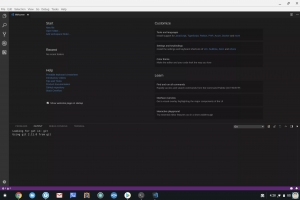

In this section, we'll go into more detail about configurations and features for more advanced debugging scenarios. Launch configs are the traditional way to set up debugging in VS Code, and provide you the most flexibility for running complex applications. Otherwise, it will try to find an installation of Chrome on your system instead.

If your default browser is Edge, VS Code will use it to open the page. When you run this command, you'll be prompted for a URL to open, and the debugger will be attached. The simplest way to debug a webpage is through the Debug: Open Link command found in the Command Palette ( ⇧⌘P (Windows, Linux Ctrl+Shift+P)).

We also have more detailed walkthroughs to get started with React, Angular, and Vue, as well as other debugging recipes. Use a launch config to launch a browser with your app.Clicking a link in the JavaScript debug terminal.Use the Open Link command to debug a URL.There are a couple ways to get started with it. Visual Studio Code includes a built-in debugger for Edge and Chrome. Configure IntelliSense for cross-compiling.This syntax is referred to as interpolated strings. The expression value is inserted into the string in place of the expression. The dollar sign ( $) in front of a string lets you put expressions such as variable names in curly braces in the string. Alternatives are \n in C# and vbCrLf in Visual Basic. NewLine is a platform-independent and language-independent way to represent a line break. Finally, it displays a prompt in the console window and calls the Console.ReadKey(Boolean) method to wait for user input. And it displays these values in the console window. It also retrieves the value of the DateTime.Now property, which contains the current local time, and assigns it to a variable named currentDate. It stores this string in a variable named name. This code displays a prompt in the console window and waits until the user enters a string followed by the Enter key. Replace the contents of the Main method in Program.cs, which is the line that calls Console.WriteLine, with the following code: Console.WriteLine("What is your name?") Ĭonsole.WriteLine($"Press any key to exit.") The program displays "Hello, World!" and ends.Įnhance the application to prompt the user for their name and display it along with the date and time. Run the following command in the Terminal: dotnet run

But it's available in C# 10, and whether you use it in your programs is a matter of style preference. Most existing C# programs don't use top-level statements, so this tutorial doesn't use this new feature. In the latest version of C#, a new feature named top-level statements lets you omit the Program class and the Main method. Any command-line arguments supplied when the application is launched are available in the args array. Main is the application entry point, the method that's called automatically by the runtime when it launches the application. The code defines a class, Program, with a single method, Main, that takes a String array as an argument. NET Core at the Select environment prompt.
#Visual studio code chromebook how to
For information about how to install extensions on Visual Studio Code, see VS Code Extension Marketplace.Ĭreate a.


 0 kommentar(er)
0 kommentar(er)
